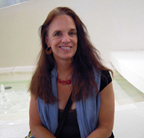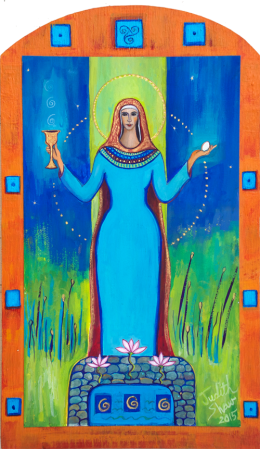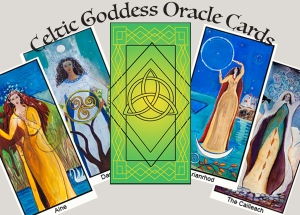 Who was Mary Magdalene? The first thought of many today is that Mary Magdalene was a repentant prostitute. But was she? Until the third century, Mary was considered an “apostle.”
Who was Mary Magdalene? The first thought of many today is that Mary Magdalene was a repentant prostitute. But was she? Until the third century, Mary was considered an “apostle.”
Mary as an apostle posed a threat to the early Church patriarchs who denied women all authority in the Church. In addition, by early in the first century C.E., Mary Magdalene had become associated with Christian thought identified as heretical by the Church. The easiest way to eliminate Mary’s importance was to cast aspersions on her moral character.
 In 597 C.E. Pope Gregory, while preaching to a congregation of brothers, conflated the figures of Mary Magdalene, Mary of Bethany, and the sinful woman of Luke 7:37, cementing her role in the Western Church as that of prostitute.
In 597 C.E. Pope Gregory, while preaching to a congregation of brothers, conflated the figures of Mary Magdalene, Mary of Bethany, and the sinful woman of Luke 7:37, cementing her role in the Western Church as that of prostitute.
Yet in the Eastern church Mary Magdalene is and was honored as a witness to the resurrection – called “apostle to the apostles” as she was the first to see the risen Jesus. On Jesus’ instructions, she goes to the others and tells them what she has seen and heard (John 20:1, 11-19). Later Jesus appears to the disciples and confirms Mary’s message as true.
The Gospels were written in Greek (which was not the language of Jesus) from oral stories 20+ years after the death of Jesus by writers who may not have known him. The earliest Gospel, Mark, was written between 50 and 90 AD. Today’s Bible was compiled 400 years after Jesus’s time, leaving out many Gospels (including the so-called Gnostic Gospels).
The Gospels, as we know them today, tell of Mary Magdalene’s constant presence as a disciple, at the crucifixion, her journey to the tomb and her vigil there while waiting to anoint his lifeless body. She was the first to witness the resurrection. Jesus spoke her name first, telling her to share the news with the others.
In the 19th century a portion of the Gospel of Mary (assumed to be Magdalene) was discovered. The original two fragments in Greek were written during the 3rd century, while the longest version in Coptic was composed during the 5th. This Gospel reflects the thoughts of an early Christian community which honored her memory and presented a strong view of the positive role played by Mary Magdalene in the Gospel of John.
In this Gospel Jesus expressed the idea that God is within each of us. The risen Jesus said “Acquire my peace within yourselves… For the child of true Humanity exists within you. Follow it! Those who search for it will find it.” Here Jesus did not describe humans as sinful.
Much of what Mary recounts as the teaching she received in a vision of Jesus is lost but Peter and his brother, Andrew, accuse Mary of lying. They called these ideas strange and expressed their jealousy of her.
Over time legends have grown up around Mary Magdalene which continue today – inspiring books and movies that have no basis in the facts as laid out by the New Testament.
Many of the Gnostic texts portray Mary Magdalene as Christ’s Most Beloved Disciple, reporting that Jesus often kissed her on the mouth and called her “Woman Who Knows All.” Perhaps it is these discarded Gnostic texts which have generated these legends, in particular the belief that Mary was the wife of Jesus and that they had a child together.
Others believe that they participated in the Sacred Marriage and were re-enacting the Egyptian Osiris’ resurrection story. The tradition of the dying and reborn God has ancient roots in the Near East. The Redeemer/King was called upon to sacrifice himself for the good of the people. When Mary anointed Jesus’ head with oil, his words prophesied his own death: “She has come beforehand to anoint my body for burial. . . What this woman has done will be told as a memorial to her” (Mark 14:8-9). Perhaps it is this belief which has led to the concept of Mary Magdalene as a Priestess of Isis.
In France a legend grew up around Mary Magdalene during the 4th century CE. It recounts that after the crucifixion three Marys landed at Saintes Maries-de-la-Mere. This legend says that each settled in a different area of France. Mary Magdalene started a church and lived out her life in a grotto on the hill of Saint Baume, named after the holy balm for which she is known.
Additionally this legend says that they carried with them “the earthen vessel that held the blood of Christ.” Many believe that Mary Magdalen herself was the earthen vessel bearing Christ’s child. The Cathars, a Christian sect in the South of France at odds with the Church in the 12th and 13th centuries continued these beliefs until they were finally wiped out in the Albigensian Crusades led by the Roman Catholic church.
Perhaps the legends surrounding Mary Magdalene are nothing more than the human longing for the Sacred Feminine. In a time when the rule of men was strong and unmarried women were powerless – even suspect – it’s not surprising that in order for people to feel Mary Magdalene as powerful the collective imagination would make her Jesus’ wife.
But what we know from the New Testament, the Gnostic Gospels and the newly discovered Gospel of Mary is that Mary Magdalene was a strong woman who spoke her beliefs in a patriarchal world, a well-known follower of Jesus, a leader of Jesus’ disciples, a visionary with the ability to understand new concepts, and an intimate companion of Jesus. We also know that she was in conflict with some of the male disciples and that Jesus defended her in her leadership role.
Who was Mary Magdalene? Perhaps we are now ready to reclaim Mary Magdalene as a strong, visionary woman…a teacher, a leader, a woman who could turn men’s hearts toward good…the first Apostle.
Sources:http://www.biblicalheritage.org/people/marymag.htm, http://www.sacredmysterytours.com/mary-magdalene/, http://www.biblicalarchaeology.org/daily/people-cultures-in-the-bible/people-in-the-bible/was-mary-magdalene-wife-of-jesus-was-mary-magdalene-a-prostitute/, http://www.brigidsplace.org/uploads/3/7/5/3/37537169/for_your_inspiration_%E2%80%93_more_about_mary_magdalene.pdf
Judith Shaw, a graduate of the San Francisco Art Institute, has been interested in myth, culture and mystical studies all her life. Not long after graduating from SFAI, while living in Greece, Judith began exploring the Goddess in her artwork. She continues to be inspired by the Divine Feminine in all of Her manifestations. Originally from New Orleans, Judith now makes her home in New Mexico where she paints and teaches part-time. She is currently hard at work on a deck of Goddess cards. Her work, which expresses her belief in the interconnectedness of all life, can be seen on her website.
Judith’s deck of Celtic Goddess Oracle Cards is available now.  You can order your deck on Judith’s website. Experience the wisdom of the Celtic Goddesses!
You can order your deck on Judith’s website. Experience the wisdom of the Celtic Goddesses!


What a beautiful and well-researched post. Thank you so much, Judith Shaw!
LikeLike
“In a time when the rule of men was strong and unmarried women were powerless – even suspect – it’s not surprising that in order for people to feel Mary Magdalene as powerful the collective imagination would make her Jesus’ wife.”
Interesting that this tendency is found even today! On the one hand it is an affirmation of sexuality to imagine that Jesus and Mary Magdalene were married. On the other hand, the image of Mary M as married does make the image of a strong female power less frightening to some. As in: after all, even if she fought with the male disciples, don’t forget that she loved and made loved with a man too.
LikeLike
I love it that your Mary M is holding the communion cup in one hand, and instead of bread the egg of rebirth and regeneration. The implication being that she is a Christian priest(ess) who has not forgotten pre-Christian wisdom.
LikeLike
Thank you for a lovely presentation on Mary Magdalene. Currently, I am reading a provocative and well researched book on her relationship to Jesus Christ that may interest many, The Lost Gospel: Decoding the Ancient Text that Reveals Jesus’ Marriage to Mary the Magdalene by Simcha Jacobovici and Barrie Wilson.
LikeLike
http://lareviewofbooks.org/review/gronking-jesus
https://www.google.gr/search?q=anthony+le+donne+wife+of+jesus&ie=utf-8&oe=utf-8&gws_rd=cr&ei=x45lVZqlDsLWUf6Tg5AN
LikeLike
I have been very interested in Mary and when I spent six months in Rome in 2013 researching my book, Lupa and Lamb, I began to think of Mary as a version of Lupa, the she-wolf who is also a prostitute in the sense that this is the meaning of the word Lupa in Latin. Of course, the stories don’t completely match, in myth they never do, but the congruences are still there. In Rome, especially in the catacombes you see many variations on the Mary figure. Both Lupa and Mary also have three incarnations: with Lupa there is the young woman who is raped(also called Ilia, who is also Rhea Silvia, the mother of Romulus and Remus), there is the wolf (Lupa = wolf), and there is the foster mother Acca Larentia who is the mother of 12 sons, one has died and takes in the twins which makes 13.
It is all fascinating stuff.
LikeLike
Thanks for sharing your profound and beautiful artwork at FAR, Judith!! How wonderful the sense in this painting that the Magdalene, the first Apostle, IS in herself a door. That’s so great. As you make clear, she definitely has her own life experience, her own wisdom, to invite us into.
LikeLike
Beautiful post, Judith. LOVE your iconic painting! For a fictional treatment of Mary Magdalen, I invite FAR readers to explore The Maeve Chronicles: http://elizabethcunninghamwrites.com/books
LikeLike
Some sources also talk about Magdala as a prosperous town built on fishing and textiles (dye) Mary is, I think, the only woman in the Jewish and Christian Scriptures who is not “linked” to a man as his wife, servant, daughter. I picture her as a wealthy, independent, successful business woman who provided dyed cloth for nobility. She had the money to provide for Jesus and the disciples. She moved about freely. I suspect she was a woman of strength and a “no-nonsense” person to be reckoned with….otherwise the men would not have attacked her.
LikeLike
Barbara, I found that info about Mary being a prosperous independent woman also but was unable to include it due to the already long essay. Ah – the problems of the cutting room floor. Thanks for mentioning it here.
LikeLike
Thanks to all for your comments. And a particular thanks to my friend Carol Christ whose input steered me out of the maze I had gotten lost in as I attempted to put together this piece showing some of the Biblical “facts” and the legends. Carol, I also love. the symbolism of the egg which I discovered in other paintings of Mary M; the cup I see more as the Holy Grail – the womb from which we all come – but it also has the Christian meaning of the communion cup. And of course I resonate deeply with the concept that Mary Magdalene was a priestess, in touch with the wisdom of the Goddess.
I think I’ve always been attracted to the concept of a union of Jesus and Mary as that reclaims sexuality as a holy part of our existence in this world. But the work on this essay led me to the thought about the need to see her as married to make her acceptable thus diminishing her power somewhat.
Sarah, thanks for catching the symbol of the door. As so often happens for me, symbols appear which I did not put there consciously – I rely on others to find them.
And thanks to all who have given more books and links to read. I feel my discovery of Mary Magdalene has just begun.
LikeLike
Brava! I belonged to a women’s circle that studied Holy Blood/Holy Grail when it came out. Of course we all believed every word of it. Plus all the other nifty books about Mary Magdalene. I also have a book about conspiracy theories (including one that says W was the one who bombed the World Trade Center, though I don’t remember why). The chapter about HB/HG is titled “Holy Blood/Holy Grail/Holy Sh-t.” Mary was no doubt the apostle to the jealous male apostles, but perhaps HB/HG went a bit too far.
I recommend Elizabeth Cunningham’s Maeve novels to one and all. They’re beautifully written. Maeve is the Celtic Mary Magdalen, she first encounters Jesus in a vision, then meets him in person at a Druid school. She leads an interesting life that includes an apotheosis.
LikeLike
Judith,
Thank you so much for this beautiful portrait of Mary Magdalene – Christ’s most beloved apostle. Your research is spot on! I would only add that although Aramaic was Jesus/Yeshua’s primary tongue, Greek was the common language among all citizen’s of the Roman empire – as residents of Galilee and Judea were considered to be – and would have been considered as a secondary language (along with Hebrew) for him as well.
After 20 years of research on Jesus, Mary Magdalene, and the early Judeo-Christian community, I am thrilled to announce the debut of my long anticipated novel, “Miriamne the Magdala – The First Chapter in the Yeshua and Miri Novel Series”! This historical-fiction novel series follows Jesus and Mary Magdalene during the so-called “missing years” and throughout their lives. The introductory novel, “Miriamne the Magdala”, explores the deeply personal relationship between twelve year old Miriamne and her long lost cousin, Yeshua bar Joseph – Jesus’ Aramaic name. Their tale begins with an unexpected reunion of two Jewish Houses and goes on to explain how a family brought together by a seeming circumstance is ultimately tied together by Destiny. When a family tragedy strikes and Yeshua and Miri are placed in a dangerous situation, heavenly forces intervene and a divine legacy that must be kept secret to all but their closest family members is revealed.
If you’d like more information about my book or the novel series, please join me here at: http://www.miriandyeshuanovelseries.com
JB Richards, Author
LikeLike